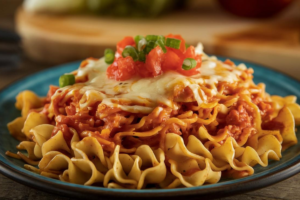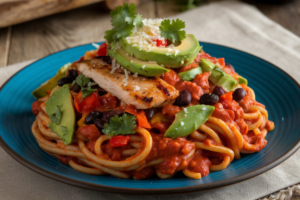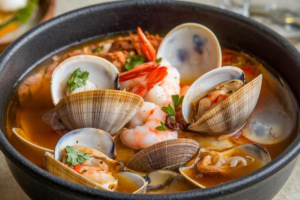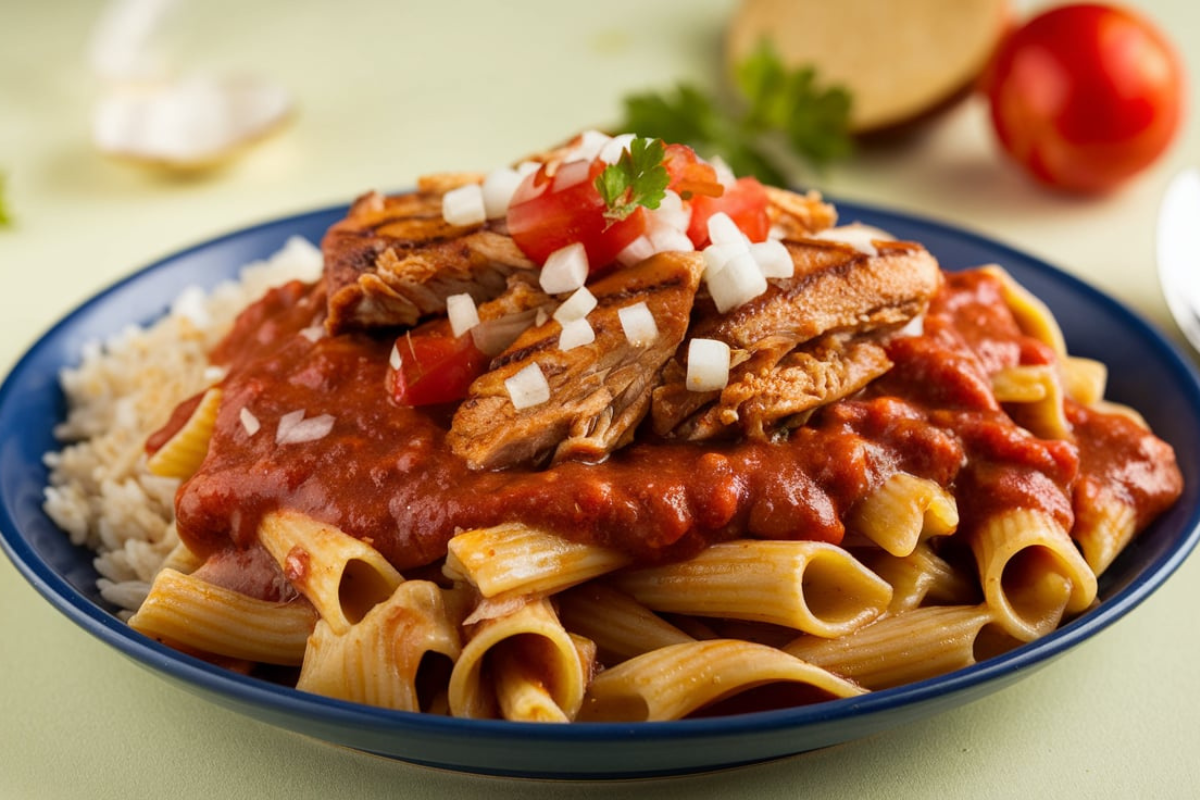Mexican cuisine is celebrated for its bold flavors, vibrant colors, and rich history. When people think of Mexican food, they often imagine tacos, enchiladas, or tamales. However, it may surprise some to learn that pasta also plays a role in Mexican cooking. While pasta is not as common as in Italian cuisine, Mexican dishes with pasta offer a unique twist. These dishes reflect the country’s diverse culture and culinary creativity. This article will explore the different ways Mexican cuisine uses pasta, from traditional to modern dishes, and the cultural significance behind this unexpected fusion.
The Role of Pasta in Mexican Cuisine
Does Mexican cuisine use pasta in its dishes? Yes, it does, through cultural exchange and adaptation. European colonization, especially by Spain, introduced new ingredients and cooking methods to Mexico. Over time, Mexican cooks began experimenting with these new ingredients, including pasta, to create dishes that blended Mexican flavors with European styles. For example, dishes like Fideo and Espagueti Rojo show how pasta fits within Mexican culinary traditions. To learn more about the history of these influences, you can check out this overview of Mexican cuisine.
Mexican pasta dishes differ from Italian ones in both preparation and flavor. Mexican recipes often use traditional ingredients like tomatoes, onions, garlic, and various spices to create unique and savory meals. Many Mexican pasta recipes, such as Fideo Seco, instruct cooks to toast the pasta in oil before simmering it in a sauce or broth. This technique adds a distinct flavor and texture to the dish. If you want to try a traditional recipe that shows how Mexican cuisine uses pasta, consider this Fideo Seco recipe.
Historical Background of Pasta in Mexican Cuisine
Does Mexican cuisine use pasta due to its historical roots? Absolutely. Pasta became part of Mexican cuisine during the colonial era when Spanish settlers brought European food traditions to the New World. They introduced wheat-based products, including noodles and pasta, to the Mexican diet. Early Mexican cooks used these ingredients in simple soups and broths, but they eventually incorporated pasta into a variety of dishes. Over time, Mexican chefs began to experiment with pasta, blending it with local flavors and ingredients. This fusion created a distinct style that combines Mexican and European influences, leading to the unique dishes we enjoy today.
Traditional Mexican Pasta Dishes
Mexican pasta dishes showcase the versatility of pasta within the cuisine. Here are some of the most popular dishes in Mexico that use pasta:
1. Fideo (Mexican Noodles)
Fideo is a popular noodle dish in Mexico, often made with vermicelli or angel hair pasta. Cooks usually toast the noodles in oil before cooking them in a flavorful tomato-based broth. This toasting adds a nutty flavor and keeps the noodles from getting mushy. Some variations include:

- Fideo Soup (Sopa de Fideo): A hearty soup that many Mexican homes serve regularly. It contains a tomato broth and often includes vegetables like carrots and potatoes.
- Fideo Seco: A drier version where the noodles absorb all the liquid. This preparation makes the dish similar to pasta but with a distinct Mexican twist. Cooks often serve it with toppings like avocado, cheese, and sour cream.
2. Espagueti Rojo (Mexican Spaghetti)
Another example of how Mexican cuisine uses pasta is Espagueti Rojo. This dish features spaghetti in a tomato-based sauce seasoned with garlic, onion, and Mexican spices. It is a staple in many Mexican homes and usually comes with cheese and a side of vegetables. Unlike Italian spaghetti, Espagueti Rojo uses a sauce enriched with spices unique to Mexican cooking, like cumin and chili powder. It is a versatile dish that families can adapt with various ingredients, making it popular for meals.

3. Sopa de Conchas (Shell Soup)
Sopa de Conchas is a comforting soup made with small shell pasta, cooked in a tomato or chicken broth, and flavored with garlic, onion, and herbs. This dish is popular with children due to its mild flavor and fun shape. The shell pasta captures the broth’s flavors, creating a satisfying and tasty soup. This dish is another answer to the question, “Does Mexican cuisine use pasta?”

4. Sopa de Coditos (Elbow Macaroni Soup)
Sopa de Coditos is similar to Sopa de Conchas, but it uses elbow macaroni and typically features a broth base. Cooks may also add ingredients like ham, cheese, or vegetables, making it a versatile and filling soup. Families often serve Sopa de Coditos at gatherings, and children especially love it. The elbow macaroni adds a chewy texture that pairs well with the savory broth and other ingredients.
5. Fideo Aguado (Brothy Noodles)
Fideo Aguado is another popular Mexican pasta dish. It features noodles cooked in a brothy tomato sauce with vegetables and sometimes meat. Cooks simmer the noodles until they become soft and absorb the broth’s flavors. This dish resembles a noodle soup and often serves as a comforting meal during colder months. The combination of noodles, broth, and vegetables creates a warming and satisfying dish perfect for family meals.
Regional Variations of Mexican Pasta Dishes
The way Mexican cuisine uses pasta varies by region. Different regions in Mexico have developed their own versions of these dishes, often influenced by local ingredients and culinary traditions. For example:
- In Northern Mexico, where cattle ranching is common, cooks often include more meat and cheese in pasta dishes, reflecting the region’s ranching culture.
- In Central Mexico, popular dishes like Fideo and Espagueti Rojo frequently feature local vegetables and spices.
- In Southern Mexico and the Yucatán Peninsula, chefs often incorporate seafood or tropical flavors into pasta dishes, reflecting the coastal environment and access to fresh fish and shellfish.
Modern Adaptations and Fusion Dishes
Recently, chefs have embraced a trend of fusion dishes that combine Mexican and Italian flavors, showcasing how Mexican cuisine uses pasta in innovative ways. These modern adaptations introduce new ingredients and methods to traditional Mexican pasta dishes, resulting in a unique mix of flavors. Here are some popular modern adaptations:
1. Mexican-Style Pasta with Three-Chile Sauce (Fideo Seco A Los Tres Chiles)
This modern dish uses traditional Mexican spices like chipotle, guajillo, and ancho chiles to create a rich and smoky pasta dish. Cooks prepare the pasta until it absorbs all the flavors, resulting in a meal that is both comforting and flavorful. This dish demonstrates how Mexican cuisine continues to evolve. It incorporates new ingredients and methods while staying true to its traditional roots.
2. Tex-Mex Pasta
Tex-Mex cuisine, a fusion of American and Mexican traditions, has also embraced pasta. Dishes like Tex-Mex spaghetti or taco pasta combine classic Mexican flavors with pasta, creating hearty and satisfying meals. These dishes often include ingredients like ground beef, cheese, tomatoes, and spices, creating a fusion of flavors that appeal to a wide audience. Tex-Mex pasta dishes are particularly popular in the United States and frequently appear on the menus of Mexican-American restaurants.
3. Vegan and Vegetarian Mexican Pasta Dishes
With the rise of vegan and vegetarian diets, many chefs have adapted Mexican pasta dishes to fit these preferences. For example:
- Vegan Fideo Soup: Cooks make this dish with vegetable broth and fresh vegetables, providing a nutritious and tasty option for those following a plant-based diet.
- Vegetarian Espagueti Verde: A creamy pasta dish made with green poblano sauce, cream, and cheese offers a vegetarian alternative to traditional meat-based pasta dishes.
Health Benefits and Nutritional Aspects of Mexican Pasta Dishes
Mexican pasta dishes can be both tasty and nutritious, depending on the ingredients used. Here are some health benefits:
- Rich in Fiber: Many Mexican pasta dishes include vegetables and beans, which are high in fiber and aid digestion.
- Good Source of Protein: Dishes that contain meat, beans, or cheese provide a good source of protein, essential for muscle building and repair.
- Variety of Vitamins and Minerals: Vegetables like tomatoes, onions, and peppers are rich in vitamins A, C, and K, as well as minerals like potassium and magnesium.
For a healthier twist, try using whole wheat pasta or adding more vegetables to the dish. This boosts the nutritional value and enhances the flavors and textures. To explore the health benefits of Mexican dishes further,visit this Healthline article.
Tips for Making Mexican Pasta Dishes Healthier
To make Mexican pasta dishes healthier, consider these tips:
- Use Whole Wheat or Gluten-Free Pasta: These options provide more fiber and nutrients compared to traditional pasta.
- Add More Vegetables: Including a variety of vegetables in the dish increases its nutritional content and adds more flavor and texture.
- Reduce Sodium: Choose low-sodium broths and sauces to cut down on the overall sodium content of the dish.
- Select Lean Proteins: Use lean meats like chicken or turkey, or opt for plant-based proteins like beans or lentils.
Frequently Asked Questions (FAQs)
- Does Mexican cuisine traditionally use pasta?
Yes, Mexican cuisine uses pasta in several traditional dishes, such as Fideo and Espagueti Rojo. - What are some authentic Mexican pasta dishes?
Authentic dishes include Fideo, Espagueti Rojo, Sopa de Conchas, and Sopa de Coditos. - How is Mexican pasta different from Italian pasta?
Mexican pasta dishes often use different spices and cooking methods, such as toasting the pasta before simmering it in a broth or sauce. This gives them a unique flavor. - Can I make Mexican pasta dishes vegetarian or vegan?
Absolutely! Many Mexican pasta dishes can easily become vegetarian or vegan by using plant-based proteins and avoiding dairy. - What are the best side dishes to serve with Mexican pasta?
Great side dishes include refried beans, avocado salad, or homemade tortilla chips with salsa or guacamole.
Conclusion and Final Thoughts
In conclusion, while pasta is not the first thing that comes to mind when thinking about Mexican cuisine, it has certainly found its place in various traditional and modern dishes. The blend of Mexican and European culinary traditions has led to the creation of unique and flavorful pasta dishes that continue to evolve. Whether you want to try a traditional recipe like Fideo or experiment with a modern dish like Mexican-style pasta with a three-chile sauce, there are plenty of options to explore. So, gather your ingredients and enjoy a delicious blend of flavors that brings the best of both worlds to your table!
By embracing both traditional and modern influences, Mexican cuisine continues to innovate and delight. This proves that pasta can indeed be a versatile and delicious part of its culinary landscape.

